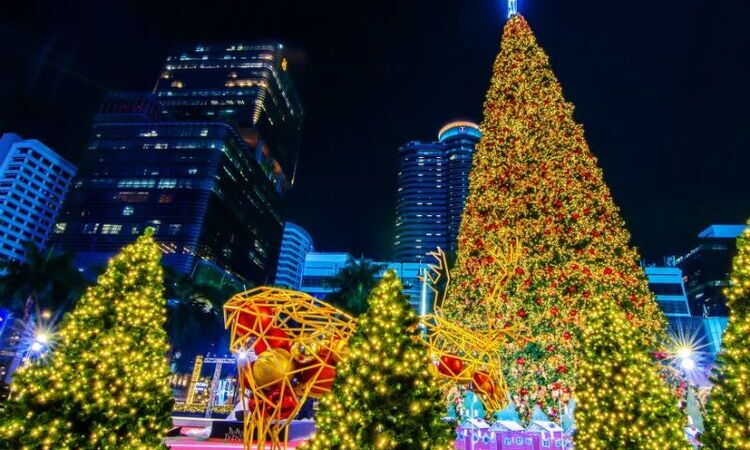Vietnam Northern Loop: The Mountain Idyll
With fewer crowds, age-old culture, scenic routes, sweeping landscapes, heavenly crisp air, and a dose of outdoor activities, Vietnamese mountain is as compelling as other big hits.
.jpg)
Most travelers to Vietnam follow the same trail that covers five popular destinations: Hanoi, Halong Bay, Hue, Hoi An, and Saigon. They are not only well-known worldwide, but also easy to travel with short flights between them. But let me tell you this, Vietnam has so much more, from the exotic beaches to the mist-shrouded mountain peaks, to take your Vietnam trip to the next level.
While the beach always makes it a much easier travel option for me with numerous accommodation choices, ranging from low-budget hotels to luxury resorts, the mountain has its own reasons to attract both a leisurely me and the adventurous in me. With fewer crowds, age-old culture, scenic routes, sweeping landscapes, heavenly crisp air, and daily outdoor activities, Vietnamese mountain is as compelling as other big hits. And believe me, even if you’re a first-timer, you might still want to consider one or more mountain destinations for a much greater Vietnam trip.
1. Tu Le. Bucolic Setting and Natural Hot Springs
- Location: Yen Bai Province
- Area: 11/sq mi
- Population (2019): 6,269
- Main ethnic group: Thai
.jpg)
The bucolic rural setting in Tu Le.
About 250 kilometers from Hanoi, on National Highway 32 heading to Mu Cang Chai, Tu Le is a far-flung valley surrounded by three high mountains: Khau Song, Khau Than, and Khau Pha. Tu Le is famed for its charming scenery and natural hot mineral springs - the biggest attractions of the place.
I arrived Tu Le at the end of the morning. While rice terraces in other parts of the northern mountain were still green, some fields here were ready to harvest. The scent of new rice followed my every step when I walked through the village. Tu Le is natured with streams that provide idyllic landscapes and irrigation for the fertile fields.
In Ban Tao village, people were cutting rice with sickles in the fields. Farmers stacked up rice plants on the path and let them dry naturally under the sunlight before threshing them. Rice straws will be dried and stored to make fodder for cattle in winter. In Tu Le, the local people are still farming in the traditional method, as I saw in my father’s homeland more than 20 years ago.
Nature favors Tu Le with hot springs, spoken far and near. The hot springs are so abundant that villagers can have their own small pools. Thai people believe that mineral spring water is a miracle cure for many diseases and makes Thai women’s skin so soft and youthful.
Suggested Accommodation:
.jpg)
- Le Champ Tu Le
Opened in 2019, Le Cham is the first and only luxury resort in Tu Le so far. Ninety-six rooms and bungalows were built on the gentle slope, offering sophisticated designs and views of the lovely town, mountains, and vast valley. There is a natural hot mineral swimming pool (photo above) where guests enjoy having a dip while seeing the farmers working on their fields just a few steps away.
The resort also offers adventurous activities for families with children, such as zipline, zorbing, bouldering, and high robe courses.
2. Mu Cang Chai. Vietnam's Most Artistic Terraced Fields
- Location: Yen Bai Province
- Area: 462.5/sq mi
- Population (2019): 63,961
- Main ethnic group: Hmong (91%)
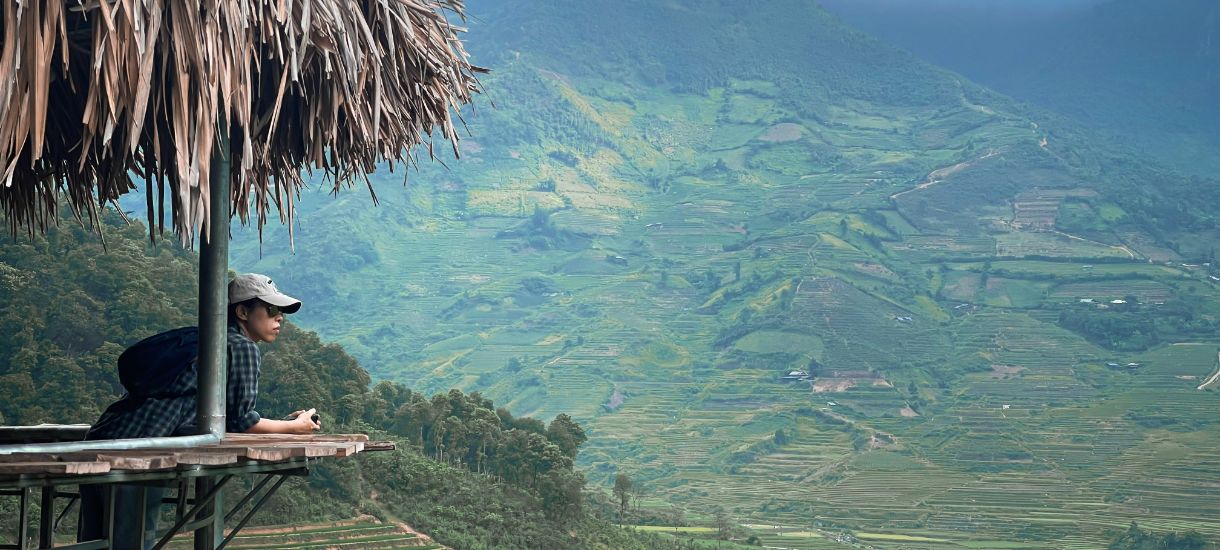
Stunning view from Gio Cafe, Khau Pha Pass
From Tu Le, I drove on the Khau Pha Pass to Mu Cang Chai - the next destination. Gio Cafe, a nice stop located on Khau Pha Pass, offers spectacular views of the valley below. There were peach trees in the garden that I was welcome to pick and try its fruits.
I passed through many magnificent sceneries before reaching Mu Cang Chai Town. For centuries, the Black Hmong have cultivated their rice on sloping hills so beautifully that it lures photographers, hikers, and nature enthusiasts to come to witness its charm every year. They used to travel the hills and mountains mainly by foot and have created excellent hiking trails for us. Thang, who has years of experience as a guide, introduced me to two hiking routes that connect Hmong villages and zigzag into the mountain.
Mu Cang Chai has long been deemed one of the world’s most beautiful agricultural terraces thanks to the sheer rice terraces in La Pan Tan Village. We trekked the narrow paths, looked over the valleys, and were mesmerized by the brilliant green that the rice plants blanketed all the hills. It’s hard for me to describe its beauty by word of mouth. You have to see it yourself to believe that.
.jpg)
The poetic rice terraces in La Pan Tan Village
Hmong people are serious about their rice fields. They make them masterpieces of art. La Pan Tan’s Mam Xoi Hill (or Raspberry Hill) is considered the most beautiful terrace in Vietnam. The fields are like step ladders adjacent to each other. The highest one has a perfectly round shape. From the viewpoint of our hike, Mam Xoi Hill looks like the fingerprints of heaven. An architectural work of art resulted from the artist and skillful hand of Black Hmong farmers.
Does not own the poetic beauty of the La Pan Tan trekking trail, Pung Luong allowed me to dig deeper into the local life. We passed old, traditional houses scattered along the dirt road. I visited a community house where children gathered to play and women to embroider and sew.
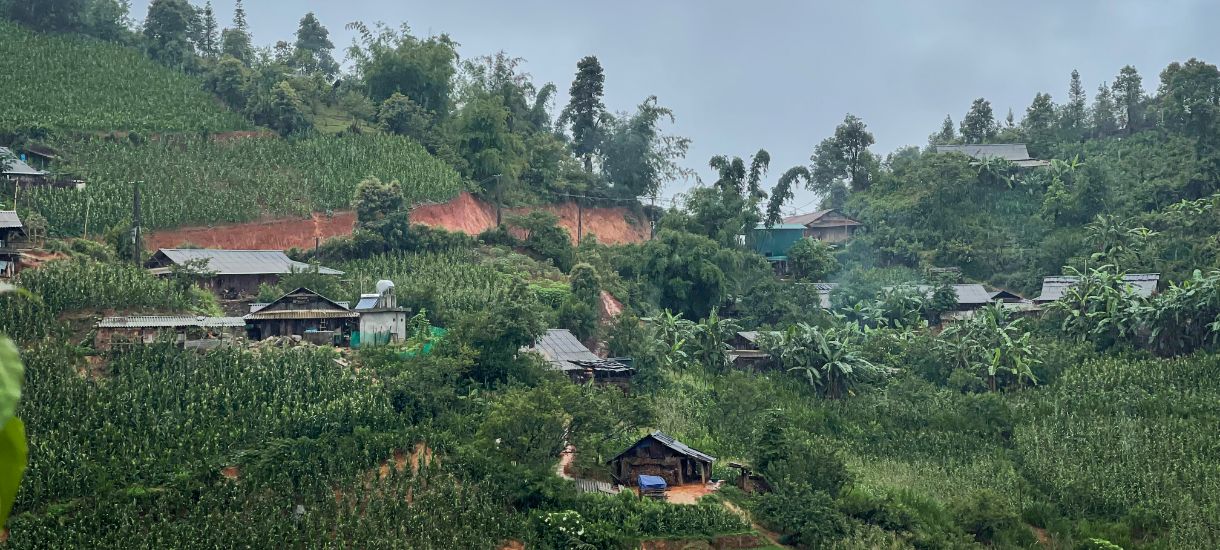
A beautiful corner of Pung Luong Village on a rainy day.
A flock of quacking ducks took us to a shabby roadside shop. When the woman knew that I was looking for a bottle of spring water, she laughed and said: “Hmong people drink water at home. They come to the shop for wine, beer, and soft drinks." The shop is also the shelter of the young couple. A thin cloth hid the bed and household items inside. Life here is so simple. We, the city dwellers, might look at their living circumstances to feel sympathy, but do they really care?
Travelers who don’t have a week to travel the mountain can always consider a two-day or three-day customized trip that covers Tu Le and Mu Cang Chai with activities to your preference. The best time to visit is from May to June in the watering season and from September to October in the ripening rice season.
Suggested Accommodations:
- Mu Cang Chai Ecolodge
Thirty kilometers from the town center, Mu Cang Chai Ecolodge offers boutique bungalows and lovely restaurants looking over the iconic paddy fields. All rooms are equipped with comfortable beds and brocade paintings that bring a sense of place. Mu Cang Chai Ecolodge tailors private hiking tours, ranging from 2-day to 4-day treks with experienced local guides to avid hikers.
3. Bac Ha. The Romantic Vibe of A Highland Town
- Location: Lao Cai Province
- Area: 262.9/sq mi
- Population (2019): 65,338
- Main ethnic group: Hmong (47%), Tay, Dzao, Phu La, La Chi
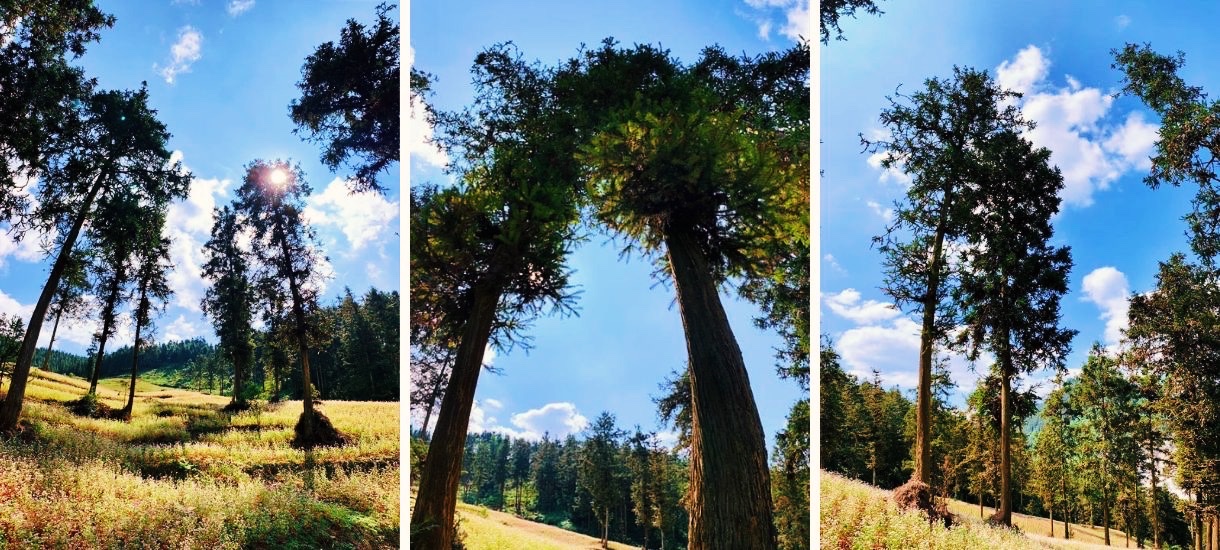
Sa Moc hills in Bac Ha town.
Located in the northeast of Lao Cai province, more than 300km from Hanoi, Bac Ha climate is cool all year round thanks to its altitude of nearly 1,000 meters above sea level. The Hmong, Tay, Dzao, Phu La, and La Chi ethnic groups make up the largest population of the region, offering a colorful multi-culture to the place.
The most popular tree in Bac Ha might be Sa Moc, a conifer tree of the pine family. People use Sa Moc wood in making houses and furniture because of its durability and unique scent. Boutique villas scattered across the hills filled with Sa moc trees in Bac Ha town. It reminded me of Da Lat 20 years ago before the tourists flocked into it. A romantic air surrounded this mountain town, bringing a unique vibe when I was sitting with a steaming hot cup of coffee in the early morning.
There are three markets in Bac Ha, therefore there will always be the possibility of one for you to visit even though they only open once a week. I missed the most famous market on Sunday. But I made my way to Coc Ly Tuesday market.
.jpg)
Buffalo market in Coc Ly
I arrived at the market at around 10.30 AM, so there wasn’t a lot of shopping. As the market opens at 7 AM, it’s better to visit earlier to experience its vibrancy. Coc Ly Market originally opened next to the suspension bridge over the Chay River. When the government decided to take that area for the Chay River hydroelectricity, they moved the market to its present location. I found everything there, from vegetables, fruits, and cloth to livestock and agricultural tools. This market has a large area for buffaloes purchasing, both adult buffaloes and calves. The sales sometimes poured water on their animals to make them feel better on a hot day. There were also holes with mud for the buffaloes to cool off.
I stopped at a young man selling plums. He said it was the plum season in Bac Ha and nowhere in Vietnam plums were as delicious as they were in Bac Ha. And he was right. The plums had berry skin, thick pulp, and a sweet taste. All these good things cost me only 25,000 VND for a kilogram (~ $1)
Another enjoyable activity in Bac Ha is taking a boat ride on the Chay River. This experience is less touristy and pleasant.
Suggested Accommodations:
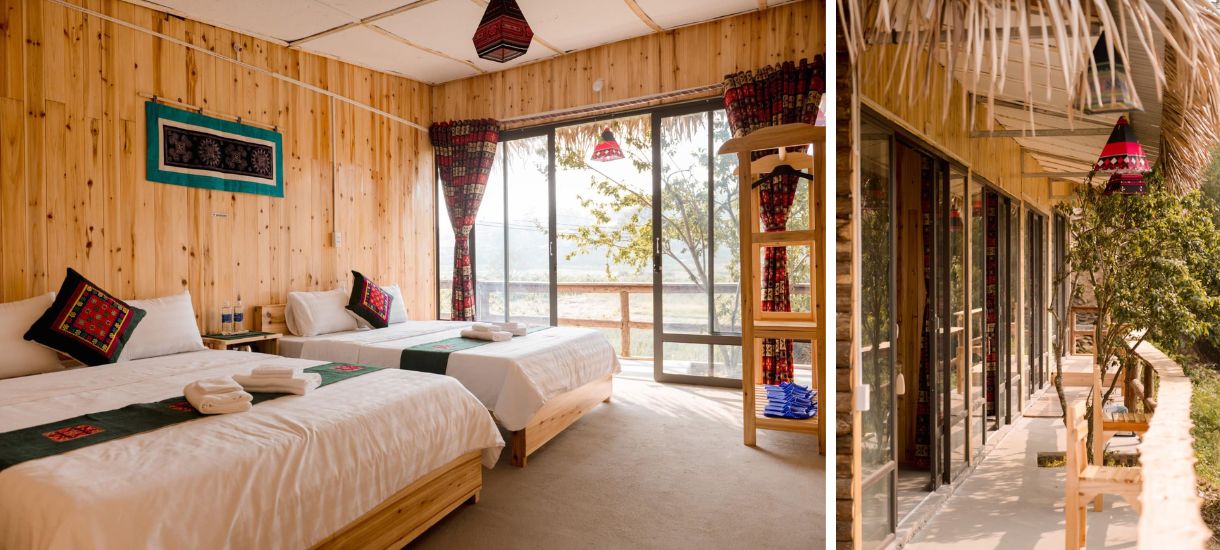
- Le Chalet Homestay:
Le Chalet (photo above) is a boutique homestay located on the hillside and looks over the plum field in Na Lo village. That means you can see farmers working in the rice field from your balcony. When going to the mountains, I usually don't expect much from coffee, but the coffee at Le Chalet was really good.
- Bac Ha Boutique
This boutique hotel is near the infamous Bac Ha Sunday market, making it’s great location if you want to feel the atmosphere of the town. Rooms are clean and designed with local touches. Some feature a balcony with river views.
4. Hoang Su Phi. Waking Up in The Cloud
- Location: Ha Giang Province
- Area: 244/sq mi
- Population (2019): 66,683
- Main ethnic group: Nung, Dzao, Hmong
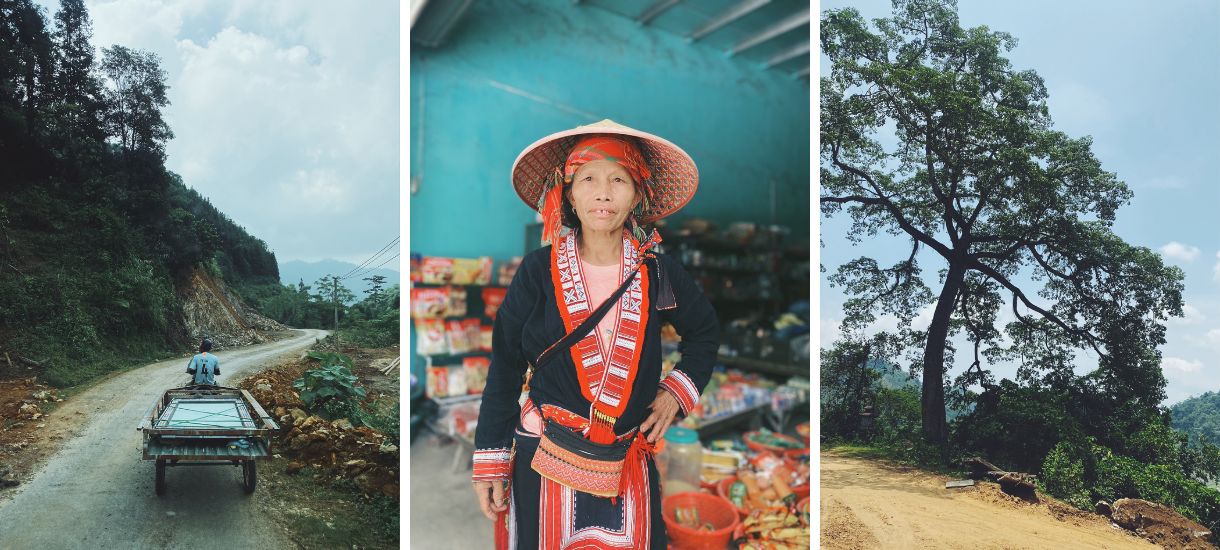
Zigzag roads to Hoang Su Phi and a Dzao woman in her colorful costume.
Hoang Su Phi is quite similar to Mu Cang Chai but with fewer tourists due to the hard road with lots of zigzag slopes, twists, and turns to get there. But isn’t that an advantage for maintaining the authenticity of the culture and nature? You will find here one of the most majestic rice terraces, ethnic groups, vibrant cultures, and pristine nature.
There are many villages in Hoang Su Phi boasting stunning landscapes of rice terraces, but I chose Thong Nguyen to stay. Three large streams Phin Ho, Nam Ong, and Nam Khoa converge at a place, forming the beautiful village of Thong Nguyen in the middle of the mountains. Due to its location, the ancients often likened Thong Nguyen to the future land of a bright future.
.jpg)
Rice terraces and mist valleys in Thong Nguyen Village
The road to Thong Nguyen was such a challenge. Some paths were muddy dirt due to the last night’s rain. Some were being repaired in a government project, so it was even more difficult for our car to move. I checked the newspapers and knew that the work would be completed by the end of 2024. At that time, Hoang Su Phi will definitely be a beauty waking up after her long sleep.
Though the traveling was hard, it was nothing to the delights that we had along the way. I drove past lunging valleys wrapped in lush forests, waterfalls, and captivating terraced fields which were filled with water ready for a new crop and wrapped up in the clouds. The fields ran from the deep valley to the mountain peaks, looking like hundreds of steps to heaven. I found myself in a world away from civilization.
.jpg)
A blissful morning in Hoang Su Phi Lodge, view from my balcony
After a long day and a good dinner, my sleep was sound and deep. I woke up and felt good and refreshed. That’s the benefit of staying in the mountain. No matter how early you get up, it’s always relaxing and refreshing.
Stepping onto the balcony with a sleepy head, I thought I was walking in the thick white vapor. Clouds found their way up to the peak with me. I sat on the bamboo chair on the balcony, leaning on the wall of my room, feeling the damp morning air, enjoying the views, and waiting patiently for the first sunbeam to break the dense fog and warm up the whole valley. I was savoring the feeling of being content. A feeling that I only find when traveling Vietnam’s northern mountains.
Suggested Accommodation:
- Hoang Su Phi Lodge
12 bungalows built on the hilltop, looking over deep valleys, majestic mountains, and paddy fields. Every room has comfortable beds, large windows opening to nature, and a large balcony to relax and enjoy the breathtaking views.
- Panhou Retreat
Surrounded by the beautiful nature of Hoang Su Phi, Panhou is a retreat for body, mind, and soul healing. 25 rooms and one villa with double or twin beds are inspired by Dzao culture and sustainable materials all around the place and designed carefully to bring you closer to nature.
5. Quan Ba. A Gorgeous Dzao Village
- Location: Ha Giang Province
- Area: 214sq/mi
- Population (2018): 56,840
- Main ethnic groups: Hmong, Dzao
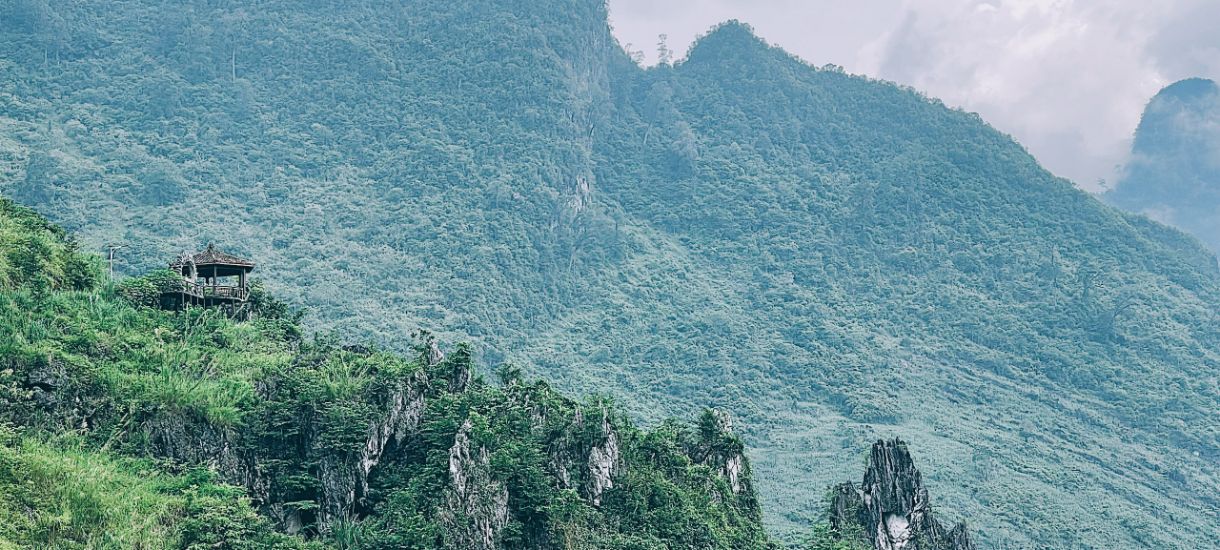
Rugged karst landscapes, Quan Ba's iconic image.
The next day, I continued my road from Hoang Su Phi to Quan Ba. If you visit Quan Ba on Saturday, you can stop at Quyet Tien Saturday market to see minority groups such as Tay, Hmong, Nung, Bo Y, and Dzao go shopping.
As I got closer to Quan Ba, the terrain changed from lush mountains and rice-terraced fields to jagged, sharp limestone cliffs and green cornfields. The rugged terrain would go with us from now to the end of our trip as it’s an iconic image of the Dong Van Karst Plateau that covers the four districts of Quan Ba, Yen Minh, Dong Van, and Meo Vac. Located at a height from 1,000 to 1,600 meters above sea level, this region has a severe climate, and a shortage of arable land and water resource, making it difficult for the residents to cultivate rice. Instead, they grow corns which can easily grow in rocky mountains and require less water.
I stayed at a traditional house in Nam Dam Village. Few people would have expected that in a remote area, there would be such a lovely village. Nam Dam Village must be famous as I found countless homestay options here. Some were simple and rustic. Others were more modern, with separate bungalows with air conditioning. I easily found typical characteristics of Dzao culture in decoration. The village paths were clean and quiet. Almost every house had pear trees laden with fruits in the garden and dry twigs for heating in the winter. Nam Dam is famous for mountain herbs that Dzao people go deep into the forest to collect. After a full day of traveling, taking a dip in the herb bath or having a foot massage with those medicinal herbs is a great way to relax and pamper yourself.
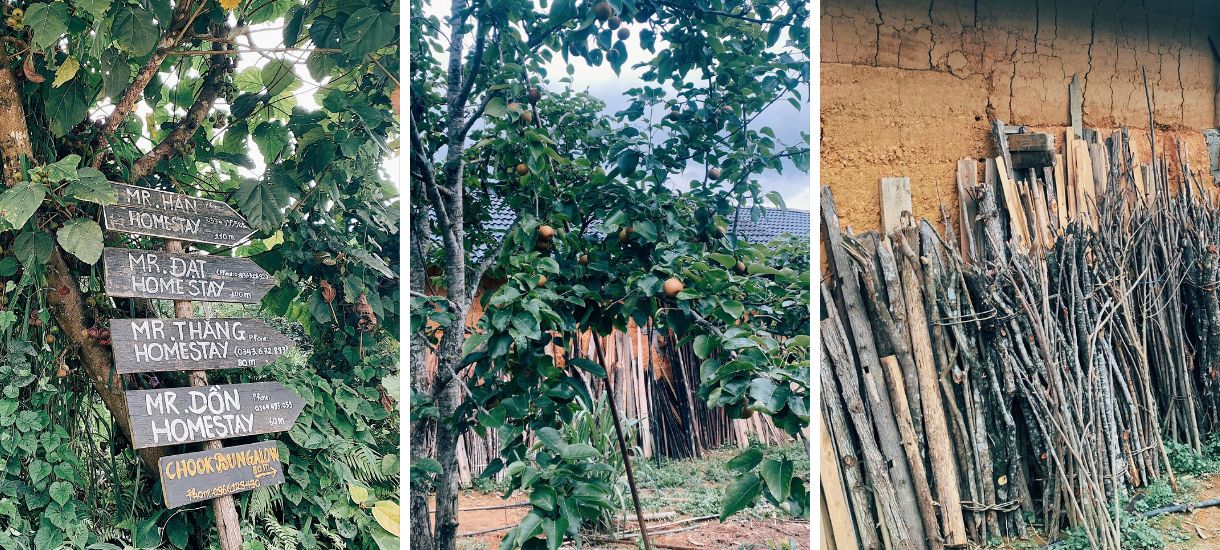
Earth-wall houses in Nam Dam Village, Quan Ba
My homestay is an old house with time-colored earthen walls and wooden tiled roofs. Three pieces of paper written in Chinese characters were pasted on the main door for luck and safe. I found three swallows nests on the ceiling. The father and mother birds kept flying in and out to feed the young in the nest. The homestay owners, a Dzao couple, cooked dinner and drank corn wine with me. Like many other mountainous villages, in Nam Dam, people welcome guests with a cup of corn wine. An elderly woman carrying her grandchild on her back taught me to speak simple words in her language. All Dzao people have gentle, brown eyes. Men’s traditional outfit is simple in black with a beret. Women dress colorfully and beautifully with a lot of silver necklaces and earrings. Dzao women also adorn their beauty with one or more gold-coated teeth.
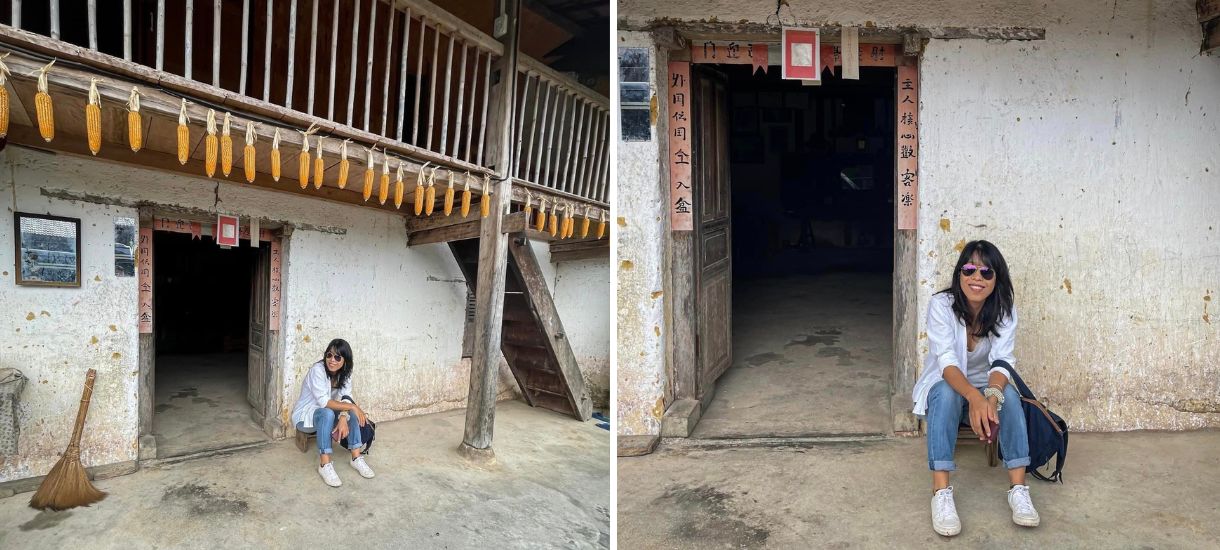
Mr. Dat's Homestay, my base for one night in Nam Dam Village
The rooms were adjacent to each other, separated by a thin wall. A fan hanging on the wall was enough to cool the small room as the temperature dropped in the evening. My friend, who was in the next room, started to sing his favorite songs. The lyrics melted in the cool crispy air of the mountainous night, subtly the beauty of homesickness.
Suggested Accommodations
- Homestays in Nam Dam Village
- Hmong Village
An upscale resort in this remote mountain. Hmong Village has 2-story houses inspired by the shape of Quay Tau - a Hmong basket. For more comfortable, book the villas with terrific views of the infamous jagged mountains. Each villa is named after the most powerful surnames of the Hmong in Ha Giang.
6. Dong Van. Life is As Beautiful, As You Want To See It
- Location: Ha Giang Province
- Area: 174/sq mi
- Population (2019): 81,880
- Main ethnic group: Hmong, Tay, Dzao
.jpg)
The scenic road trip from Quan Ba to Dong Van.
The distance between Quan Ba and Dong Van is about 100 kilometers, and it takes 3 hours to drive. Until now, we no longer wonder why it took so much time for such a short distance. You cannot go fast in the mountain in Vietnam. But the beautiful scenery makes up for all the waste of time.
On the way, we stopped at Can Ti weaving village to visit. In the old time, Hmong women used to do all the steps that included planting the hemp, making fabric from hemp stalks, weaving, embroidering, painting batik, and finally dying the fabric with indigo plants to obtain the iconic dark blue color. It could take months to make a dress. Therefore, each dress was how a Hmong girl showed off their ingenuity to young men.
1.5 hour drive from Can Ti Village, we arrived at Sa Phin Valley where the Hmong Royal Palace is on a hill of Sa Moc trees. This place was the seat of Hmong Kings who ruled the region during the French colonial era until Vietnam regained independence in 1945. The royal family gained their wealth through drug dealings. In the past, Sa Phin Commune served as a trafficking hub for Myanmar, China, and Indochina. Opium poppy fruit-shaped decorations are found in many corners of the palace. There is an interesting fact about Hmong King’s life. He made a brotherhood with Ho Chi Minh - the great leader of the Vietnamese Communist revolutionary.
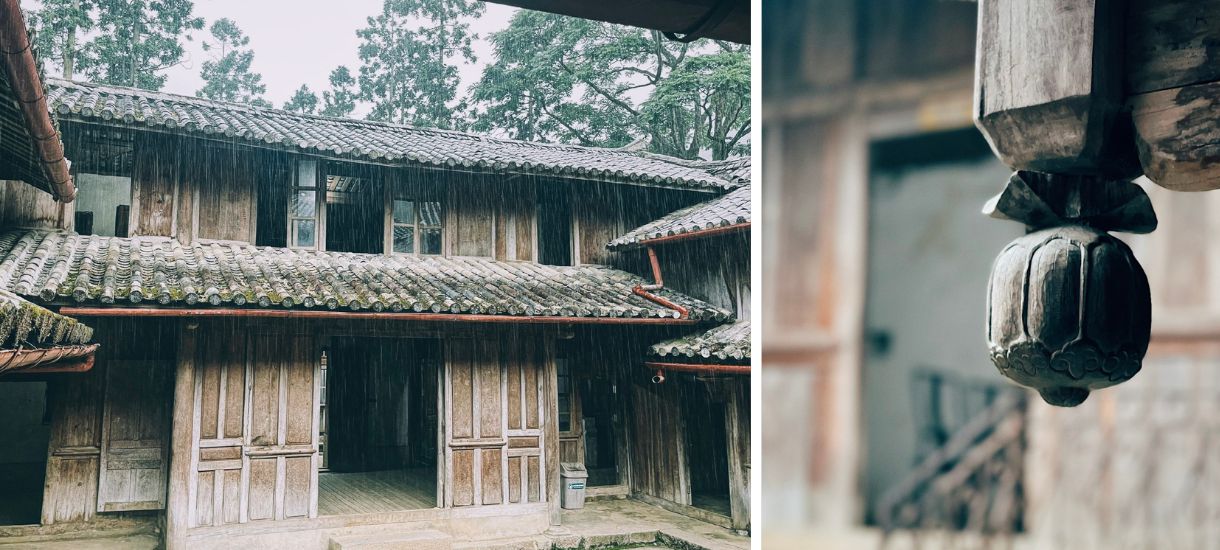
Hmong King Palace and opium poppy fruit-shaped decorations.
We stayed at Ecostone House. My room has large windows looking over the green rice paddies. The bathroom has a rain shower, a wooden bathtub, and, again, views of nature. The mattress was soft, the room was clean, and every item was attentively cared for by the owner. For a tired traveler, I wished nothing more.
From the house, it is only a few minutes from the old town. I fell in love with it right at the first sign. Hundred-year-old traditional “Trinh Tuong” houses with yin-yang roofs leaning against the foot of rugged mountains make up the distinctive look of Dong Van, distinguishing it from other towns. Even though it is small, it’s easy to find a restaurant for good food, a cafe with a diverse menu, and a cool bar to wind down your evening for a solo drink in town.
.jpg)
A corner of Dong Van Old Town on a rainy day. A fairy atmosphere between dream and reality.
I stopped at a massage center and booked a body massage treatment - a self-reward for all the traveling in the last five days. My masseuse was a 16-year-old Hmong girl who finished secondary school one year ago. Her parents are working away from home. She and her three siblings stayed with their grandparents. She works during the week to save money for her further education and goes home every weekend to help her grandparents with the cornfields. Due to the lack of rice, corns serve as the staple food in the daily diet of many Hmong families. “Men Men” is what they name their corn dish. “Men Men can be yummy, depending on who is the cook. You have to try it. I can eat Men Men every day,” the girl giggled. Her answer touched me. In many books about life in the remote mountain I’ve read, Men Men is a manifestation of poverty, but with this girl, it’s the joy of eating. “Life is as beautiful as you want to see it,” isn’t that true?
Suggested Accommodations
- Ecostone House
Ecostone House is a good option if you want a cozy room. The beds and bathrooms are good. Breakfast just has a few options such as Banh Mi (Vietnamese burger), sticky rice, and Banh Cuon (steamed rice rolls.)
- Hoa Cuong Hotel
The best hotel in town. Hoa Cuong Dong Van looks much better than it is on the website. There are different room categories, suitable for solo, couples, and families. The area is moderate, the furniture is taken care of. The breakfast buffet offers both Vietnamese and international cuisine.
7. Meo Vac. River of Incredible Green Emerald
- Location: Ha Giang Province
- Area: 221.7/sq mi
- Population (2019): 86,071
- Main ethnic group: Hmong, Lo Lo, Tay, Dzao
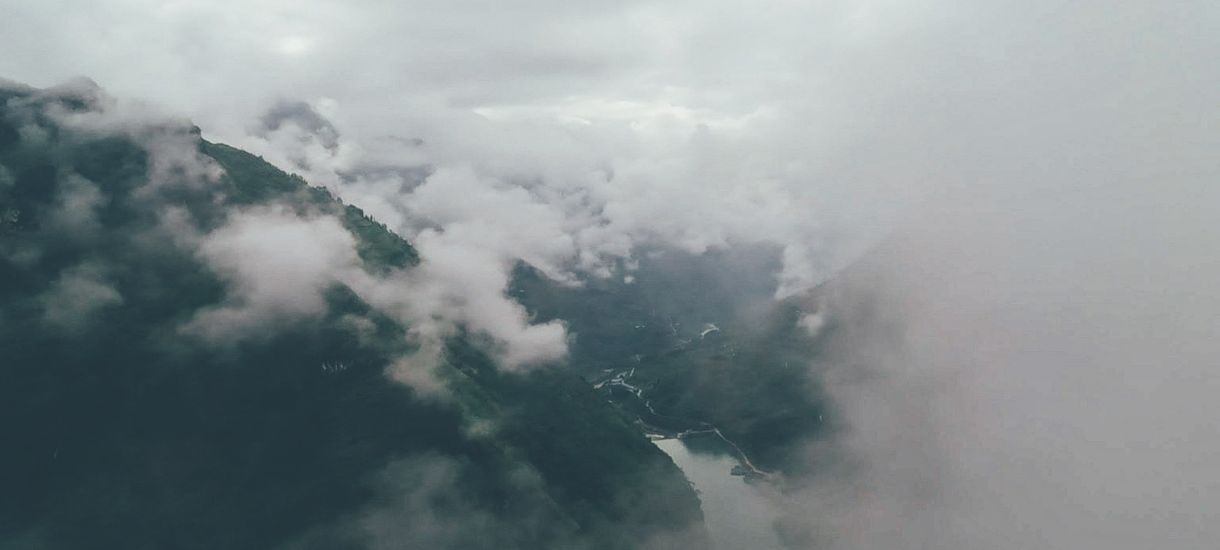
Nho Que River winding through cloud-wrapped mountain peaks, view from Ma Pi Leng Pass.
If you have traveled to Dong Van, there is no reason not to drive another 25 kilometers to Meo Vac - the border area of Ha Giang province. Meo Vac’s main attractions are the Nho Que River and Ma Pi Leng Pass - the King of Vietnam’s passes. We drove along the Road of Happiness. The road’s length is 185 kilometers, starting from Gacdie Bridge in Ha Giang town to the endpoint of Meo Vac. It took 5.5 years to complete, mainly by Vietnamese minority people and rudimentary tools.
When we accessed Ma Pi Leng Pass, the thick fog covered the view even though it was 9 AM. We waited about 7 minutes for the clouds to melt away, revealing the green Nho Que river winding through the towering mountains below. But very quickly, the curtain of fog closed, hiding the incredible beauty of nature.
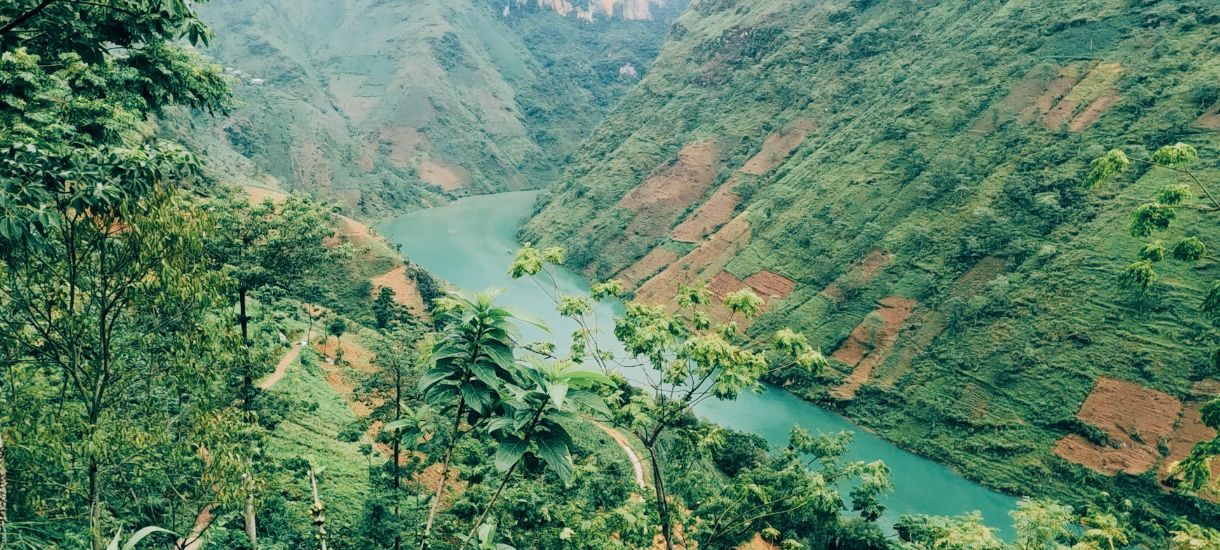
The incredible green color of the mountain river.
Driving down the pass, we arrived at the Nho Que riverboat station. The boat ticket is VND120,000/person (~$5) for a one-hour cruise. We took a 10-minute buggy drive and another 10 minutes to get to the boat pier. The boat wouldn’t set off until it had a specified number of people.
The Nho Que River’s water is incredibly green. When I looked at it from Ma Pi Leng Pass, I thought it was the reflection of the foliage, but I was wrong. It’s truly the emerald color of the river. Both sides of the river are lush mountain peaks and cornfields sprinkled with ethnic houses. We saw Hmong families working in the fields and children running around on their bare feet. Our boat reached Tu San Canyon - a deep abyss that stretches 1.7 kilometers with towering cliffs as tall as 800 meters. Mother Nature favors Meo Vac too much by giving this land such a unique geological formation.
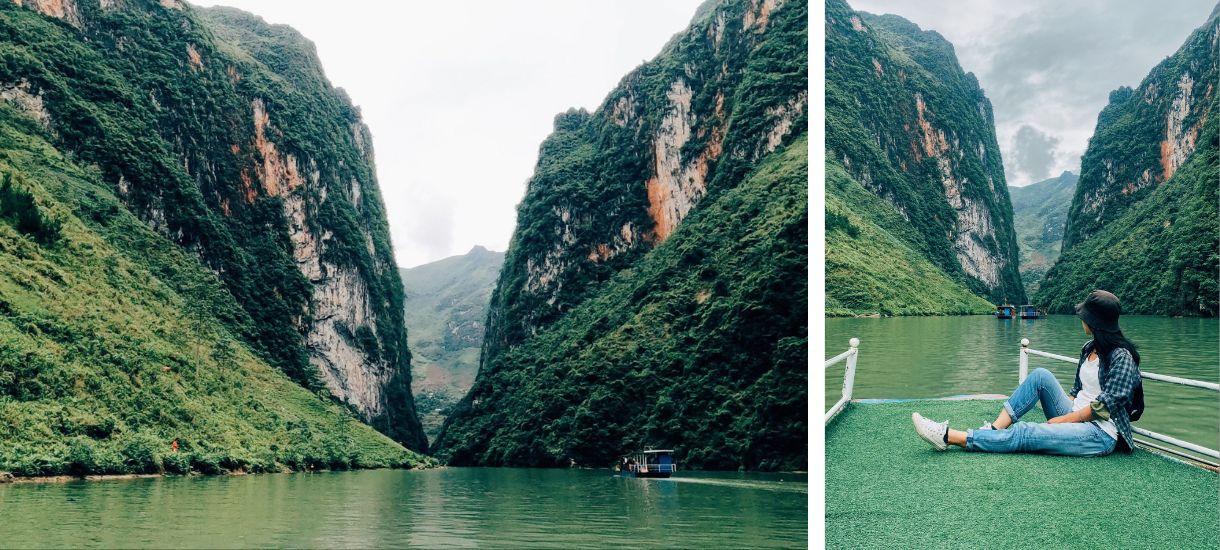
Tu San Canyon - a highlight attraction on the northern loop
Meo Vac is also famous for the Khau Vai market. This market only opens once a year on March 27 in the lunar calendar. Legend says that, long ago, a young couple could not be together because they belonged to two ethnic groups. They married and had their own family but still kept thinking about each other. They decided to meet at Khau Vai market once a year to satisfy their longing. Since then, Khau Vai love market has been the place for couples who love each other but don’t have a happy ending. Their spouses will not criticize or be jealous because they only go to the market once a year to quench their desires and expectations.
And in a quiet morning at some village halfway up the mountain, I heard the wind whisper heartfelt words that a woman asked it to pass to her lover.
Lover, come down from the mountain
Bring only a horse and go alone
I'm here waiting for you even though I'm not pretty and young anymore.
Suggested Accommodations:
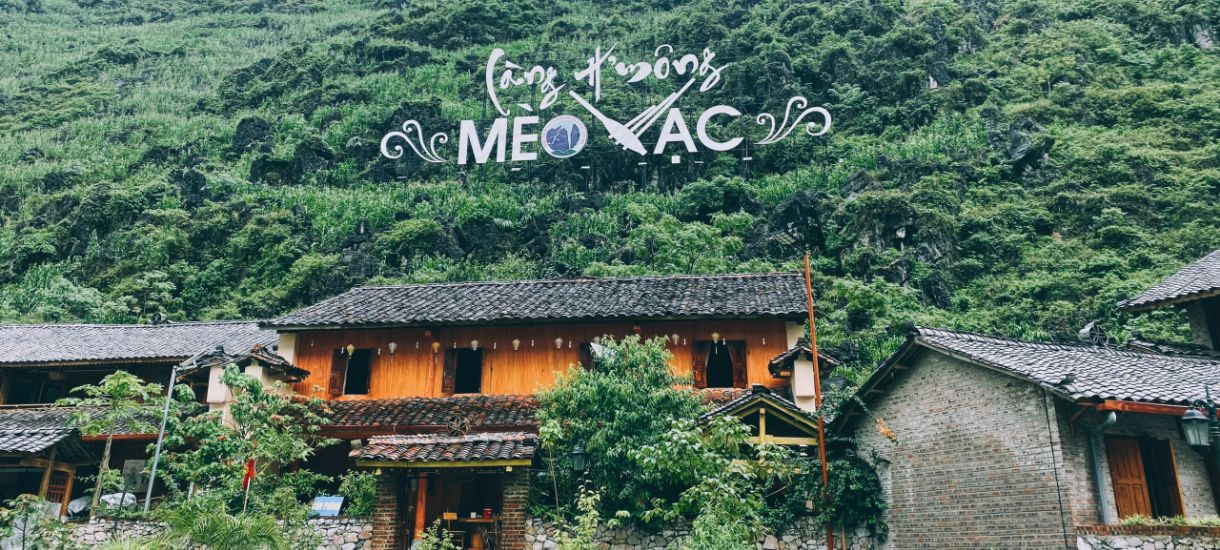
- Hmong Pa Vi Village
The village has nearly 30 households living and doing community tourism. The homestays are all clean and comfortable. Architecture and decoration have a touch of Hmong culture. Price ranges from 200,000VND to 1,500,000VND depending on if you choose a dorm or private room. Restaurants, cafes, and souvenir shops in the village make your stay more enjoyable.
- You can also travel back to Dong Van Town if you prefer a hotel stay.
John Muir, one of the most influential outdoor enthusiasts, once said: The mountains are calling and I must go. I have never been able to resist the wild attraction of this region. The warm smiles from strangers make me feel like I'm home. The fresh air that I can never find in the big cities keeps me energized and ready for every new thing in the day. And better yet, all things are just amazing and unforgettable.
Adding the mountains on your trip to Vietnam is like adding a flavorful spice to a delicious dish. If you have time, I would recommend a seven to ten-day trip. If not, five days is fine. Or even three days is enough for you to inhale the unique scent of Vietnam mountains.
If you can find some ideas after reading my article, you can require a customized tour based on what you want to have on your trip. Have no idea of a route you really like? Want to put everything in your itinerary? Share your wishes and let the mountain experts help you.



